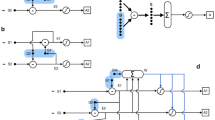Abstract
The acquisition of pain avoidance represents a major step in adaptation in terms of evolutionary biology. Organisms were randomly selected who could evolve, systems to detect pain, process its significance, and institute appropriate avoidance. This did not occur in a teleological sense—organisms cannot “will” structural changes that benefit their survival—rather, it evolved in terms of the laws of general adaptation.1
Access this chapter
Tax calculation will be finalised at checkout
Purchases are for personal use only
Preview
Unable to display preview. Download preview PDF.
Similar content being viewed by others
References
Kavaliers M. Evolutionary and comparative aspects of nociception. Brain Res Bull 1988; 21: 923–31.
Merskey DM, Bond MR, Bonica JJ, et al. Classification of chronic pain for the Study of Pain Subcommittee. Pain 1986; 13(Suppl): Sl–S226.
Levine JD, Coderre TJ, Basbaum AI. The peripheral nervous system and the inflammatory process. In Dubner R. Gebhart GF, Bond MR, eds. Proceedings of the Vth World Congress on Pain, Vol 3, Amsterdam, Elsevier, 1988.
Willis WD, Jr. The pain system: the neural basis of nociceptive transmission in the mammalian nervous system. Edenberg P, series ed. Pain and headache, Vol 8, Basel, Karger, 1985.
Yaksh TL, Bailey J. Roddy DR, et al. Peripheral release of substance P from primary afferents. In Dubner R, Gebhart GF, Bond MR, eds. Proceedings of the Vth World Congress on Pain, Vol 3, Amsterdam, Elsevier, 1988.
Vaught JL. Substance P antagonists and analgesia: review of the hypothesis. Life Sci 1988;43:1419–31.
Yaksh TL. Substance P release from knee joint afferent terminals: modulation by opioids. Brain Res 1988; 458: 319–24.
Freeman RD. Spinal substrates of visceral pain. In Yaksh TL, ed. Spinal afferent processing, New York, Plenum Press, 1986.
Dubner R, Bennett GJ. Spinal and trigeminal mechanisms of nociception. Annu Rev Neurosci 1983; 6: 381.
LaMotte CC. Organization of dorsal horn neurotransmitter systems. In Yaksh TL, ed. Spinal afferent processing, New York, Plenum Press, 1986.
Rexed B. A cytoarchitectonic atlas of the spinal cord in the cat. J Comp Neurol 1954; 100: 297.
Reynolds DV. Surgery in the rat during electrical analgesia induced by focal brain stimulation. Science 1969; 164: 444.
Mayer DJ, Wolfle TL, Akil H, Carder B, Liebesking JC. Analgesia from electrical Stimulation in the brainstem of the rat. Science 1971; 174: 1351.
Westlund KN, Coulter JD. Descending projections of the locus coeruleus and subcoeruleus/medial parabrachial nuclei in monkey: axonal transport studies and dopamine-beta-hydroxylase immunocytochemistry. Brain Rev 1980; 2: 235.
Lamotte C, Pert CB, Snyder SH. Opiate receptor binding in primate spinal cord: distribution and changes after dorsal root section. Brain Res 1976; 112: 407.
Yaksh TL, Hammond DL. Peripheral and central substrates involved in the rostrad transmission of nociceptive information. Pain 1982; 13: 1.
Ruda MA, Bennett GJ, Dubner R. Neurochemistry and neural circuitry in the dorsal horn. Prog Brain Res 1986; 66: 219.
Willis WD, Coggeshall RE. Sensory mechanisms of the spinal cord. New York, Plenum Press, 1978.
Melzack R, Wall PD. Pain mechanisms: a new theory. Science 1965; 150: 971.
Willis WD, Kenshalo DR, Jr., Leonard RD. The cells of origin of the primate spinothalamic tract. J Comp Neurol 1979; 188: 543.
Kevetter GA, Haber LH, Yesierski RP, et al. Cells or origin of the spinoreticular tract in the monkey. J Comp Neurol 1982; 207: 61.
Hylden JL, Hayashi H, Bennett GJ. Lamina I spinomesencephalic neurons in the cat ascend via the dorsolateral funiculi. Somatosens Res 1986; 4: 31.
Truex RC, Taylor JM, Smyth MQ, Gildenberg PL. The lateral cervical nucleus of cat, dog and man. J Comp Neurol 1970; 139: 93.
Handbook of spinal anaesthesia and analgesia, Covino BG, Scott DB, Lambert DH eds. Philadelphia, W.B. Saunders, 1994, pp 32–33.
Wilson PR. Sympathetically-maintained pain. In Stanton-Hicks M, ed. Pain and the sympathetic nervous system, Boston, Kluwer Academic, 1990.
Buchanan JM, Baldasera J, Poole PH, et al. Postoperative pain relief: a new approach: narcotics compared with non-steroidal anti-inflammatory drugs. Ann R Coll Surg Engl 1988; 70: 332–35.
Yeager MP, Glass DD, Neff RK, et al. Epidural anesthesia and analgesia in high-risk surgical patients. Anesthesiology 1987; 66: 729–36.
Wall PD. The prevention of postoperative pain (editorial), Pain 1988; 33: 289–90.
Janig W. Pathophysiology of nerve following mechanical injury. In Dubner R, Gebhart GF, Bond MR, eds. Proceedings of the Vth World Congress on Pain, Vol 3, Amsterdam, Elsevier, 1988.
Dyck PJ. Hypoxic neuropathy: does hypoxia play a role in diabetic neuropathy? Neurology 1989; 39: 111–18.
Devor M. Gorvin-Lippman R, Raber P. Corticosteriods suppress ectopic neuronal discharge originating in experimental neurons. Pain 1985; 22: 110–37.
Wall PD, Gutnick M. Properties of afferent nerve impulses originating from a neuron. Nature 1987; 248: 740–43.
Plowsky I. Abnormal illness behavior (dysnosognosia). Psychother Psychosom 1986; 46: 76–84.
American Psychiatric Association. Diagnosis and statistical manual of mental disorder, ed 3, Washington D.C., American Psychiatric Association, 1987.
Foley KM. Pain syndromes in patients with cancer. Adv Pain Res Ther 1979; 2: 59–75.
Goldenberg DL. Fibromyalgia syndrome: an emerging but controversial condition. JAMA 1987; 257: 2782–87.
Editor information
Editors and Affiliations
Rights and permissions
Copyright information
© 1998 Springer Science+Business Media New York
About this chapter
Cite this chapter
Blackwell, R.E., Olive, D.L. (1998). Physiology of Pain. In: Blackwell, R.E., Olive, D.L. (eds) Chronic Pelvic Pain. Springer, New York, NY. https://doi.org/10.1007/978-1-4612-1752-7_2
Download citation
DOI: https://doi.org/10.1007/978-1-4612-1752-7_2
Publisher Name: Springer, New York, NY
Print ISBN: 978-1-4612-7265-6
Online ISBN: 978-1-4612-1752-7
eBook Packages: Springer Book Archive




